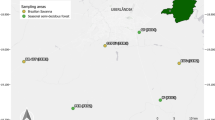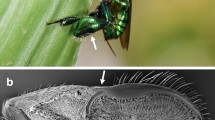Abstract
Male neotropical orchid bees collect volatile substances from their environment and compose complex, species-specific odour blends in leg pouches. These perfumes are accumulated by the males over time and are exposed during pre-mating display. It has been hypothesized that perfumes are indicators of male genotypic quality and that females chose mates by the quality or intensity of their odour. Because direct experimental proof is lacking, we investigated whether the amount or complexity of male perfumes is related to male (1) size, (2) fluctuating (left–right) asymmetry, or (3) age, traits that are known to be sexually selected in other animals. We measured left and right forewings (cell node distances for 1 and 2, wing wear for 3) of Euglossa dilemma and Euglossa viridissima collected during dry and rainy seasons on the Yucatán peninsula, Mexico (total N = 768). Wing size was not related to the quantity or the complexity of perfume extracts in either species after excluding the effect of season, which positively affected both size and perfume load in E. dilemma. Wing asymmetry had also no effect, except in rainy season E. viridissima, where it was positively (not negatively) correlated with the quantity of perfume. Wing wear, an established age indicator of orchid bees, had the only consistent overall effect, being positively correlated with perfume amount and complexity in both species. This is in agreement with the idea that perfumes are an honest indicator of male survival capacity.

Similar content being viewed by others
References
Alcock J (1996) The relation between male body size, fighting, and mating success in Dawson’s burrowing bee, Amegilla dawsoni (Apidae, Apinae, Anthophorini). J Zool 239:663–674
Amin MR, Bussiere LF, Goulson D (2012) Effects of male age and size on mating success in the bumblebee Bombus terrestris. J Insect Behav 25:362–374
Andersson M (1994) Sexual selection. Princeton University Press, New Jersey
Archer CR, Zajitschek F, Sakaluk SK, Royle NJ, Hunt J (2012) Sexual selection affects the evolution of lifespan and ageing in the decorated cricket Gryllodes sigillatus. Evolution 66:3088–3100
Bonduriansky R, Maklakov A, Zajitschek F, Brooks R (2008) Sexual selection, sexual conflict and the evolution of ageing and life span. Funct Ecol 22:443–453
Brooks R, Kemp DJ (2001) Can older males deliver the good genes? TREE 16:308–313
Dressler RL (1982) Biology of the orchid bees (Euglossini). Ann Rev Ecol Syst 13:373–394
Eltz T (1997) Zur Duftstoffbiologie neotropischer Prachtbienen (Apidae: Euglossini). Diplomarbeit, Universität Würzburg, Germany, pp 104
Eltz T, Whitten WM, Roubik DW, Linsenmair KE (1999) Fragrance collection, storage, and accumulation by individual male orchid bees. J Chem Ecol 25:157–176
Eltz T, Roubik DW, Whitten WM (2003) Fragrances, male display and mating behaviour of Euglossa hemichlora: a flight cage experiment. Phys Entomol 28:251–260
Eltz T, Roubik DW, Lunau K (2005a) Experience-dependent choices ensure species-specific fragrance accumulation in male orchid bees. Behav Ecol Sociobiol 59:149–156
Eltz T, Sager A, Lunau K (2005b) Juggling with volatiles: exposure of perfumes by displaying male orchid bees. J Comp Physiol A 191:575–581
Eltz T et al (2007) Enfleurage, lipid recycling and the origin of perfume collection in orchid bees. Proc Royal Soc B Biol Sci 274:2843–2848
Friedl TWP, Klump GM (2005) Sexual selection in the lek-breeding European treefrog: body size, chorus attendance, random mating and good genes. Anim Behav 70:1141–1154
Jaffe R, Moritz RFA (2010) Mating flights select for symmetry in honeybee drones (Apis mellifera). Naturwissenschaften 97:337–343
Kim JY, Thorp RW (2001) Maternal investment and size-number trade-off in a bee, Megachile apicalis, in seasonal environments. Oecologia 126:451–456
Manning JT (1985) Choosy females and correlates of male age. J Theor Biol 116:349–354
May-Itzá WdJ, Medina Medina LA, Medina S, Paxton RJ, Quezada-Euán JJG (2014) Seasonal nest characteristics of a facultatively social orchid bee, Euglossa viridissima, in the Yucatan Peninsula, Mexico. Insectes Soc 61:183–190
Moller AP, Alatalo RV (1999) Good-genes effects in sexual selection. Proc Royal Soc B Biol Sci 266:85–91
Peruquetti RC (2003) Variação do tamanho corporal de machos de Eulaema nigrita Lepeletier (Hymenoptera, Apidae, Euglossini). Resposta materna à flutuação de recursos? [Body size variation in males of Eulaema nigrita Lepeletier (Hymenoptera, Apidae, Euglossini). Maternal response to resource fluctuation?]. Rev Bras Zool 20:207–212
Pokorny T et al (2013) Acquisition of species-specific perfume blends: influence of habitat-dependent compound availability on odour choices of male orchid bees (Euglossa spp.). Oecologia 172:417–425
Roulston TH, Cane JH (2000) The effect of diet breadth and nesting ecology on body size variation in bees (Apiformes). J Kansas Entomol Soc 73:129–142
Schemske DW, Lande R (1984) Fragrance collection and territorial display by male orchid bees. Anim Behav 32:935–937
Severinghaus LL, Kurtak BH, Eickwort GC (1981) The reproductive behavior of Anthidium manicatum (Hymenoptera: Megachilidae) and the significance of size for territorial males. Behav Ecol Sociobiol 9:51–58
Silva MC, Lomonaco C, Augusto SC, Kerr WE (2009) Climatic and anthropic influence on size and fluctuating asymmetry of Euglossine bees (Hymenoptera: Apidae) in a semideciduous seasonal forest reserve. Genet Mol Res 8:730–737
Stone GN, Loder PMJ, Blackburn TM (1995) Foraging and courtship behavior in males of the solitary bee Anthophora plumipes (Hymenoptera, Anthophoridae): thermal physiology and the roles of body-size. Ecol Entomol 20:169–183
Strohm E (2000) Factors affecting body size and fat content in a digger wasp. Oecologia 123:184–191
Tepedino VJ, Thompson R, Torchio PF (1984) Heritability for size in the Megachilid bee Osmia lignaria propinqua Cresson. Apidologie 15:83–87
Villalobos EM, Shelly TE (1991) Correlates of male mating success in two species of Anthidium bees (Hymenoptera: Megachilidae). Behav Ecol Sociobiol 29:47–53
Villanueva RA, Quezada-Euan JJG, Eltz T (2013) Pollen diets of two sibling orchid bee species, Euglossa, in Yucatán, southern Mexico. Apidologie 44:440–446
Vogel S (1966) Parfümsammelnde Bienen als Bestäuber von Orchidaceen und Gloxinia. Österr Bot Z 113:302–361
Watson PJ, Thornhill R (1994) Fluctuating asymmetry and sexual selection. TREE 9:21–25
Whitten WM, Young AM, Stern DL (1993) Nonfloral sources of chemicals that attract male euglossine bees (Apidae: Euglossini). J Chem Ecol 19:3017–3027
Zimmermann Y, Ramírez SR, Eltz T (2009) Chemical niche differentiation among sympatric species of orchid bees. Ecology 90:2994–3008
Acknowledgments
Jorge Ramirez-Pech helped with sample collection. Funding was provided by the German Science Foundation (EL 249/6) to TE. and the PROALMEX program (120989) of the German Academic Exchange Service and the Consejo Nacional de Ciencia y Tecnologı´a (103341) to TE and JQE.
Author information
Authors and Affiliations
Corresponding author
Additional information
Handling Editor: Michael Heethoff.
Rights and permissions
About this article
Cite this article
Eltz, T., Bause, C., Hund, K. et al. Correlates of perfume load in male orchid bees. Chemoecology 25, 193–199 (2015). https://doi.org/10.1007/s00049-015-0190-9
Received:
Accepted:
Published:
Issue Date:
DOI: https://doi.org/10.1007/s00049-015-0190-9




